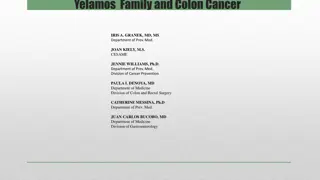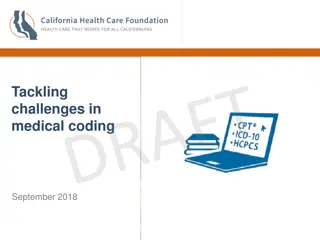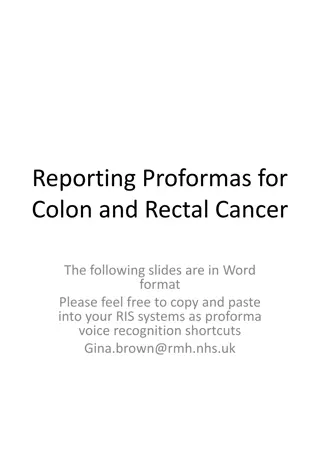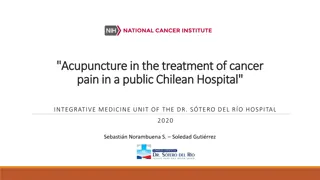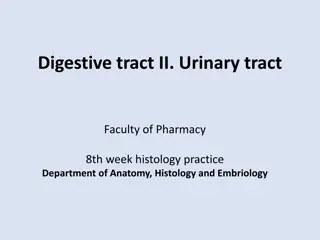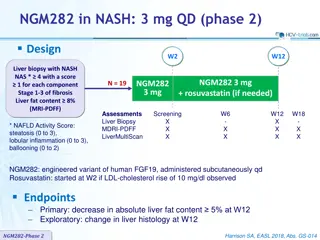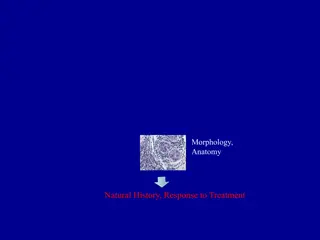Guidelines for Multiple Primary & Histology Coding in Colon Cancer Abstractor Training
Utilize the Multiple Primary & Histology Coding Rules for accurate case abstraction. Understand equivalent terms, definitions, and instructions to determine multiple primaries for solid malignant tumors diagnosed after January 1, 2007. Avoid relying on physician statements and prioritize following the specified rules to assess recurrence and single primaries effectively.
Download Presentation

Please find below an Image/Link to download the presentation.
The content on the website is provided AS IS for your information and personal use only. It may not be sold, licensed, or shared on other websites without obtaining consent from the author. Download presentation by click this link. If you encounter any issues during the download, it is possible that the publisher has removed the file from their server.
E N D
Presentation Transcript
Multiple Primary and Histology Coding Rules Colon Cancer KCR Abstractor s Training November 16-18, 2016 Nicole Catlett, CTR
Multiple Primary & Histology Coding Rules It is very important to use the MPH rules for each case you are abstracting. There are specific instructions for each primary site modules. MAKE SURE YOU READ THROUGH THE RULES OR YOU MAY CODE THE CASE INCORRECTLY!
MPH General Instructions EQUIVALENT OR EQUAL TERMS Adenocarcinoma, glandular carcinoma Multicentric, multifocal Tumor, mass, lesion, neoplasm
MPH General Instructions DEFINITIONS Contiguous tumor: A single tumor that involves, invades, or bridges adjacent or connecting sites or subsites. Focal: An adjective meaning limited to one specific area. A focal cancer is limited to one specific area or organ. The area may be microscopic or macroscopic. Foci: Plural of focus. Focus: A term used by pathologists to describe a group of cells that can be seen only by a microscope. The cells are noticeably different from the surrounding tissue either by their appearance, chemical stain, or other testing.
MPH General Instructions Most representative specimen: The pathologic specimen from the surgical procedure that removed the most tumor tissue. Multiple primaries: More than one reportable case. Overlapping tumor: The involved sites are adjacent (next to each other) and the tumor is contiguous. Recurrence: This term has two meanings: 1. The reappearance of disease that was thought to be cured or inactive (in remission). Recurrent cancer starts from cancer cells that were not removed or destroyed by the original therapy. 2. A new occurrence of cancer arising from cells that have nothing to do with the earlier (first) cancer. A new or another occurrence, incidence, episode, or report of the same disease (cancer) in a general sense a new occurrence of cancer. Single primary: One reportable case.
DETERMINING MULTIPLE PRIMARIES FOR SOLID MALIGNANT TUMORS General Information 1. Use these rules to determine the number of reportable primaries. 2. The rules are effective for cases diagnosed January 1, 2007 and after. Do not use these rules to abstract cases diagnosed prior to January 1, 2007. 3. Read the General Instructions and the site-specific Equivalent Terms and Definitions before using the multiple primary rules. 4. The multiple primary and histology coding rules are available in three formats: flowchart, text, and matrix. The rules are identical, only the formats differ. Use the rules in the format that is easiest for you to follow. 5. Notes and examples are included with some of the rules to highlight key points or to add clarity to the rules. 6. Do not use a physician s statement to decide whether the patient has a recurrence of a previous cancer or a new primary. Use the multiple primary rules as written unless a pathologist compares the present tumor to the original tumor and states that this tumor is a recurrence of cancer from the previous primary.
How to Use the Multiple Primary Rules 1. Use the Multiple Primary rules to make a decision on the number of primary malignancies to be abstracted for reportable solid malignant tumors. 2. Use the site-specific rules for the following primary sites: Brain, malignant (intracranial and CNS) Breast Colon Head and neck Kidney Lung Malignant melanoma of the skin Renal pelvis, ureter, bladder, and other urinary 3. Use the Other Sites rules for solid malignant tumors that occur in primary sites not covered by the site-specific rules.
How to choose the appropriate module (Unknown if Single or Multiple Tumors, Single Tumor, Multiple Tumors) Use the multiple primary and histology coding rules for the primary site Determine the number of tumors Do not count metastatic lesions When the tumor is only described as multicentric or multifocal and the number of tumors is not mentioned, use the Unknown if Single or Multiple Tumors module When there is a tumor or tumors with separate microscopic foci, ignore the separate microscopic foci and use the Single Tumor or Multiple Tumor modules as appropriate
How to choose the appropriate module (Unknown if Single or Multiple Tumors, Single Tumor, Multiple Tumors) When the patient has a single tumor, use the Single Tumor module. If there are multiple tumors, use the Multiple Tumor module. Use the primary site documented by the physician on the medical record
How to Use the Multiple Primary Rules If a single primary, prepare one abstract. If there are multiple primaries, prepare two or more abstracts. Rules are in hierarchical order within each module (Unknown if Single or Multiple Tumors, Single Tumor, and Multiple Tumors). Use the first rule that applies and
Information about the 2007 Histology Coding Rules The rules are effective for cases diagnosed January 1, 2007 and after. Do not use these rules to abstract cases diagnosed prior to January 1, 2007. The histology coding rules are available in three formats: flowchart, text, and matrix. The rules are identical, only the formats differ. Use the set of rules in the format that is easiest for you to follow. Notes and examples are included with some of the rules to highlight key points or to add clarity to the rules. Rules are in hierarchical order within each section (Single Tumor and Multiple Tumors Abstracted as a Single Primary).
How to Use the Rules 1. Read the General Instructions. 2. Read the site-specific Equivalent Terms and Definitions. 3. Use these rules to make a decision on coding the histology for all reportable solid malignant tumors. 4. Use the multiple primary rules to determine whether the patient has a single or multiple primaries before coding the histology. 5. Code the histology for each primary in a separate abstract.
How to Use the Rules 6. Use the site-specific rules for the following primary sites: Brain, malignant (intracranial and CNS) Breast Colon Head and neck Kidney Lung Malignant melanoma of the skin Renal pelvis, ureter, bladder, and other urinary
How to Use the Rules 7. Use the Other Sites rules for all solid malignant tumors that occur in primary sites not included in the site-specific rules. 8. Determine whether the patient has a single tumor or multiple tumors that will be abstracted as a single primary a. Do not count metastatic tumors b. When the tumor is described as multifocal or multicentric, use the Multiple Tumors module c. When there is a tumor or tumors with separate foci of tumor do not count the foci d. Only count the tumors that will be used to prepare that abstract. For example, when there are two tumors that will be abstracted as multiple primaries, you would use the Single Tumor modules to determine the histology code for each of the abstracts.
How to Use the Rules 9. Each section (Single Tumor and Multiple Tumors Abstracted as a Single Primary) is an independent, complete set of coding rules. For example, if the patient has multiple tumors, that will be abstracted as a single primary start with the first rule under the heading Multiple Tumors Abstracted as a Single Primary. Do not use any of the rules under the header Single Tumor. 10. Use the first rule that applies and
Priority order for using Documents to Code Histology 1. Pathology report: a. From the most representative tumor specimen examined b. From the final diagnosis Note 1: Use information from addenda and comments associated with the final diagnosis to code the histology. Note 2: A revised/amended diagnosis replaces the original final diagnosis. Code the histology from the revised/amended diagnosis. Note 3: The new rules limit the information to the final diagnosis. The old rules allowed coding from information in the microscopic description. You will only use information from the microscopic portion of the pathology report when instructed to do so in one of the site-specific rules.
Priority order for using Documents to Code Histology 2. Cytology report. 3. When you do not have either a pathology report or cytology report: a. Documentation in the medical record that references pathology or cytology findings b. From mention of type of cancer (histology) in the medical record
Ambiguous Terms Used to Code Histology Ambiguous terms that are characteristic (used to code histology) Apparent(ly) Appears Comparable with Compatible with Consistent with Favor(s) Most likely Presumed Probable Suspect(ed) Suspicious (for) Typical (of) Example: Non-small cell carcinoma, most likely adenocarcinoma. Code adenocarcinoma.
Colon Equivalent Terms Note: For the purpose of these rules, the words exophytic and polypoid are not synonymous with a polyp Familial polyposis, familial adenomatous polyposis, (FAP) Intramucosal, lateral extension Invasion through colon wall, extension through colon wall, transmural Low grade neuroendocrine carcinoma, carcinoid Most invasive, most extensive Mucin producing, mucin secreting Mucinous, colloid Polyp, adenoma Serosa, visceral peritoneum Tumor, mass, lesion, neoplasm Type, subtype, predominantly, with features of, major, or with ____differentiation.
Definitions Adenocarcinoid (8245/3): A specific histology commonly found in the appendix. Adenocarcinoma with mixed subtypes (8255): Rarely used for colon primaries (see introduction). Adenocarcinoma, intestinal type (8144) is a form of stomach cancer. Do not use this code when the tumor arises in the colon. Adenoma: A benign lesion composed of tubular or villous structures showing intraepithelial neoplasia (See definition of intraepithelial neoplasia) Composite carcinoid (8244): One tumor which contains both carcinoid and adenocarcinoma.
Definitions Familial polyposis, familial adenomatous polyposis (FAP), adenocarcinoma in: a condition characterized by the development of many adenomatous polyps, often seen in several members of the same family. Frank adenocarcinoma: Adenocarcinoma arising from the colon wall (no evidence of a polyp) In Situ: Noninvasive; intraepithelial; (adeno)carcinoma in a polyp or adenoma, noninvasive. Intestinal type adenocarcinoma (8144) is a gastric histology term and is not listed in the WHO Histological Classification of Tumors of the Colon and Rectum.
Definitions Intraepithelial neoplasia, high grade may be either severe dysplasia or carcinoma in situ. Report cases of carcinoma in situ only. Intraepithelial neoplasia, low grade is not a reportable condition. A person with intraepithelial neoplasia is at risk for developing invasive cancer. Intramucosal tumors may be noninvasive or invasive. The term intramucosal may refer to the surface epithelium, the basement membrane, or the lamina propria.. Invasive tumor: A tumor that penetrates the basement membrane and invades the lamina propria.
Definitions Most invasive: The tumor with the greatest continuous extension through the wall of the colon. The layers of the colon wall in order of least to greatest extension: Mucosa (surface epithelium, lamina propria, basement membrane) Submucosa Muscularis propria Subserosa (pericolic fat, subserosal fat) Retroperitoneal fat (pericolic fat) Mesenteric fat (pericolic fat) Serosa (visceral peritoneum).
Definitions Mucinous/colloid adenocarcinoma (8480): An adenocarcinoma containing extra-cellular mucin comprising more than 50% of the tumor. Note that mucin-producing and mucin-secreting are not synonymous with mucinous. Neuroendocrine carcinoma (8246): Neuroendocrine carcinoma is a group of carcinomas that include typical carcinoid tumor (8240), atypical carcinoid tumor (8249). Pericolic fat: A general term for the fat surrounding the colon. Subserosal fat, retroperitoneal fat and mesenteric fat are pericolic fat. Signet ring cell carcinoma (8490): An adenocarcinoma containing intra-cellular mucin comprising more than 50% of the tumor.
Definitions Transmural: Through the wall of the colon (the tumor has extended through the colon wall and may invade a regional organ or regional tissue. Undifferentiated carcinoma (8020): A high grade malignancy lacking glandular structures or other specific features that can be used to better classify the tumor. Undifferentiated carcinoma is not a histologic type; it is a non-specific term.
Multiple Primary Rules for Colon c18.0-18.9 Please pull out your MPH rules for Colon that I have included in your packets. We will review MPH rules for Colon.
LETS LOOK AT THE VERY IMPORTANT MPH MANUAL http://seer.cancer.gov/tools/mphrules/mphrules_text.pdf
Colon Multiple Primary Rules Text C180 - C189 (Excludes lymphoma and leukemia M9590-9989 and Kaposi sarcoma M9140)
UNKNOWN IF SINGLE OR MULTIPLE TUMORS Note: Tumor(s) not described as metastasis Rule M1 When it is not possible to determine if there is a single tumor or multiple tumors, opt for a single tumor and abstract as a single primary.* **Note: Use this rule only after all information sources have been exhausted. * Prepare one abstract. Use the histology coding rules to assign the appropriate histology code. This is the end of instructions for Unknown if Single or Multiple Tumors.
SINGLE TUMOR Note 1: Tumor not described as metastasis Note 2: Includes combinations of in situ and invasive Rule M2 A single tumor is always a single primary. * Note: The tumor may overlap onto or extend into adjacent/contiguous site or subsite. * Prepare one abstract. Use the histology coding rules to assign the appropriate histology code. This is the end of instructions for Single Tumor.
MULTIPLE TUMORS Multiple tumors may be a single primary or multiple primaries. Note 1: Tumors not described as metastases Note 2: Includes combinations of in situ and invasive Rule M3 Adenocarcinoma in adenomatous polyposis coli (familial polyposis) with one or more malignant polyps is a single primary.* Note: Tumors may be present in multiple segments of the colon or in a single segment of the colon. Rule M4 Tumors in sites with ICD-O-3 topography codes that are different at the second (Cxxx), third, (Cxxx) or fourth (C18x) character are multiple primaries. ** Rule M5 Tumors diagnosed more than one (1) year apart are multiple primaries. **
MULTIPLE TUMORS (cont.) Rule M6 An invasive tumor following an in situ tumor more than 60 days after diagnosis are multiple primaries. ** Note 1: The purpose of this rule is to ensure that the case is counted as an incident (invasive) case when incidence data are analyzed. Note 2: Abstract as multiple primaries even if the medical record/physician states it is recurrence or progression of disease. Rule M7 A frank malignant or in situ adenocarcinoma and an in situ or malignant tumor in a polyp are a single primary.*
MULTIPLE TUMORS (cont.) Rule M8 Abstract as a single primary* when one tumor is: - Cancer/malignant neoplasm, NOS (8000) and another is a specific histology or - Carcinoma, NOS (8010) and another is a specific carcinoma or - Adenocarcinoma, NOS (8140) and another is a specific adenocarcinoma or - Sarcoma, NOS (8800) and another is a specific sarcoma
MULTIPLE TUMORS (cont.) Rule M9 Multiple in situ and/or malignant polyps are a single primary.* Note: Includes all combinations of adenomatous, tubular, villous, and tubulovillous adenomas or polyps. Rule M10 Tumors with ICD-O-3 histology codes that are different at the first (xxxx), second (xxxx) or third (xxxx) number are multiple primaries. **
MULTIPLE TUMORS (cont.) Rule M11 Tumors that do not meet any of the above criteria are a single primary.* Note 1: When an invasive tumor follows an in situ tumor within 60 days, abstract as a single primary. Note 2: All cases covered by Rule M11 are in the same segment of the colon. * Prepare one abstract. Use the histology coding rules to assign the appropriate histology code. ** Prepare two or more abstracts. Use the histology coding rules to assign the appropriate histology code to each case abstracted. This is the end of instructions for Multiple Tumors.
Colon Histology Coding Rules Text C180-C189 (Excludes lymphoma and leukemia M9590-9989 and Kaposi sarcoma M9140)
SINGLE TUMOR Rule H1 Code the histology documented by the physician when there is no pathology/cytology specimen or the pathology/cytology report is not available. Note 1: Priority for using documents to code the histology * Documentation in the medical record that refers to pathologic or cytologic findings * Physician s reference to type of cancer (histology) in the medical record * CT, PET or MRI scans Note 2: Code the specific histology when documented. Note 3: Code the histology to 8000 (cancer/malignant neoplasm, NOS) or 8010 (carcinoma, NOS) as stated by the physician when nothing more specific is documented.
SINGLE TUMOR (cont.) Rule H2 Code the histology from a metastatic site when there is no pathology/cytology specimen from the primary site. Note: Code the behavior /3. Rule H3 Code 8140 (adenocarcinoma, NOS) when pathology describes only intestinal type adenocarcinoma or adenocarcinoma, intestinal type. Note 1: Intestinal type adenocarcinoma usually occurs in the stomach. Note 2: When a diagnosis of intestinal adenocarcinoma is further described by a specific term such as type, continue to the next rule.
SINGLE TUMOR (cont.) Rule H4 Code 8210 (adenocarcinoma in adenomatous polyp), 8261 (adenocarcinoma in villous adenoma), or 8263 (adenocarcinoma in tubulovillous adenoma) when: The final diagnosis is adenocarcinoma in a polyp The final diagnosis is adenocarcinoma and a residual polyp or polyp architecture is recorded in other parts of the pathology report. The final diagnosis is adenocarcinoma and there is reference to a residual or pre-existing polyp or The final diagnosis is mucinous/colloid or signet ring cell adenocarcinoma in a polyp or There is documentation that the patient had a polypectomy Note 1: It is important to know that the adenocarcinoma originated in a polyp. Note 2: Code adenocarcinoma in a polyp only when the malignancy is in the residual polyp (adenoma) or references to a pre-existing polyp (adenoma) indicate that the malignancy and the polyp (adenoma) are the same lesion.
SINGLE TUMOR (cont.) Rule H5 Code 8480 (mucinous/colloid adenocarcinoma) or 8490 (signet ring cell carcinoma) when the final diagnosis is: Mucinous/colloid (8480) or signet ring cell carcinoma (8490) or Adenocarcinoma, NOS and the microscopic description documents that 50% or more of the tumor is mucinous/colloid or Adenocarcinoma, NOS and the microscopic description documents that 50% or more of the tumor is signet ring cell carcinoma
SINGLE TUMOR (cont.) Rule H6 Code 8140 (adenocarcinoma, NOS) when the final diagnosis is adenocarcinoma and: The microscopic diagnosis states that less than 50% of the tumor is mucinous/colloid or The microscopic diagnosis states that less than 50% of the tumor is signet ring cell carcinoma or The percentage of mucinous/colloid or signet ring cell carcinoma is unknown Rule H7 Code 8255 (adenocarcinoma with mixed subtypes) when there is a combination of mucinous/colloid and signet ring cell carcinoma.
SINGLE TUMOR (cont.) Rule H8 Code 8240 (carcinoid tumor, NOS) when the diagnosis is neuroendocrine carcinoma (8246) and carcinoid tumor (8240). Rule H9 Code 8244 (composite carcinoid) when the diagnosis is adenocarcinoma and carcinoid tumor. Rule H10 Code 8245 (adenocarcinoid) when the diagnosis is exactly adenocarcinoid. Rule H11 Code the histology when only one histologic type is identified. Rule H12 Code the invasive histology when both invasive and in situ histologies are present.
SINGLE TUMOR (cont.) Rule H13 Code the most specific histologic term when the diagnosis is: Cancer/malignant neoplasm, NOS (8000) and a more specific histology or Carcinoma, NOS (8010) and a more specific carcinoma or Adenocarcinoma, NOS (8140) and a more specific adenocarcinoma or Sarcoma, NOS (8800) and a more specific sarcoma (invasive only) Note 1: The specific histology for in situ tumors may be identified as pattern, architecture, type, subtype, predominantly, with features of, major, or with ____differentiation Note 2: The specific histology for invasive tumors may be identified as type, subtype, predominantly, with features of, major, or with ____differentiation.
SINGLE TUMOR (cont.) Rule H14 Code the histology with the numerically higher ICD-O-3 code. This is the end of instructions for Single Tumor. Code the histology according to the rule that fits the case.
MULTIPLE TUMORS ABSTRACTED AS A SINGLE PRIMARY Note: These rules only apply to multiple tumors that are reported as a single primary. Rule H15 Code the histology documented by the physician when there is no pathology/cytology specimen or the pathology/cytology report is not available. Note 1: Priority for using documents to code the histology -Documentation in the medical record that refers to pathologic or cytologic findings -Physician s reference to type of cancer (histology) in the medical record -From CT, PET or MRI scans Note 2: Code the specific histology when documented. Note 3: Code the histology to 8000 (cancer/malignant neoplasm, NOS) or 8010 (carcinoma, NOS) as stated by the physician when nothing more specific is documented.
MULTIPLE TUMORS ABSTRACTED AS A SINGLE PRIMARY (cont.) Rule H16 Code the histology from a metastatic site when there is no pathology/cytology specimen from the primary site. Note: Code the behavior /3. Rule H17 Code 8220 (adenocarcinoma in adenomatous polyposis coli) when: - Clinical history says familial polyposis and final diagnosis on the pathology report from resection is adenocarcinoma in adenomatous polyps or - There are >100 polyps identified in the resected specimen or - The number of polyps is not given but the diagnosis is familial polyposis
MULTIPLE TUMORS ABSTRACTED AS A SINGLE PRIMARY (cont.) Rule H18 Code 8263 (adenocarcinoma in a tubulovillous adenoma) when multiple in situ or malignant polyps are present, at least one of which is tubulovillous Note: Use this rule only when there are multiple polyps or adenomas. Do not use this rule if there is a frank adenocarcinoma and a malignancy in a single polyp or adenoma. Rule H19 Code 8221 (adenocarcinoma in multiple adenomatous polyps) when: -There are >1 and <=100 polyps identified in the resected specimen or -There are multiple polyps (adenomas) and the number is not given and familial polyposis is not mentioned Note: Use this rule only when there are multiple polyps. Do not use for a single polyp (adenoma) or for a frank malignancy and a malignancy in a single polyp (adenoma).


